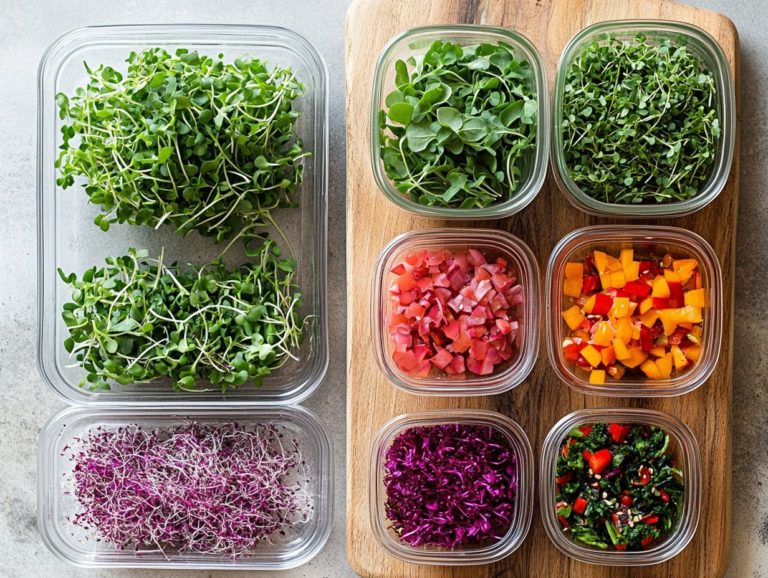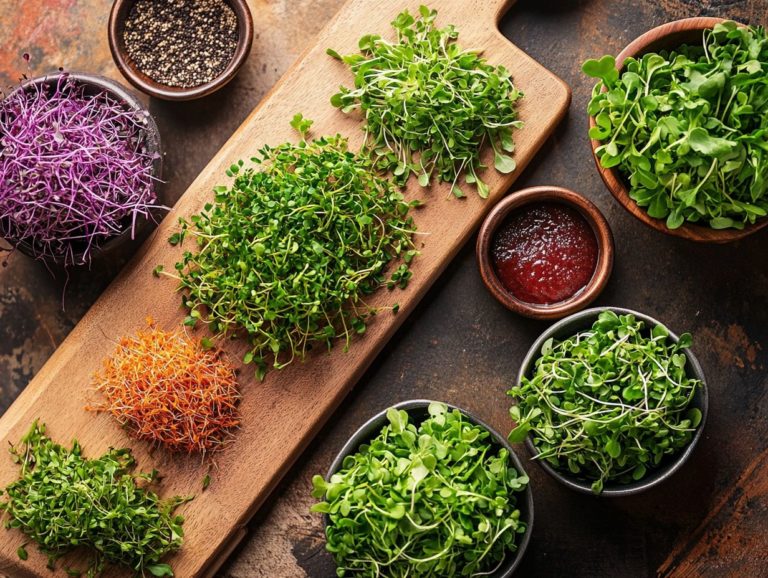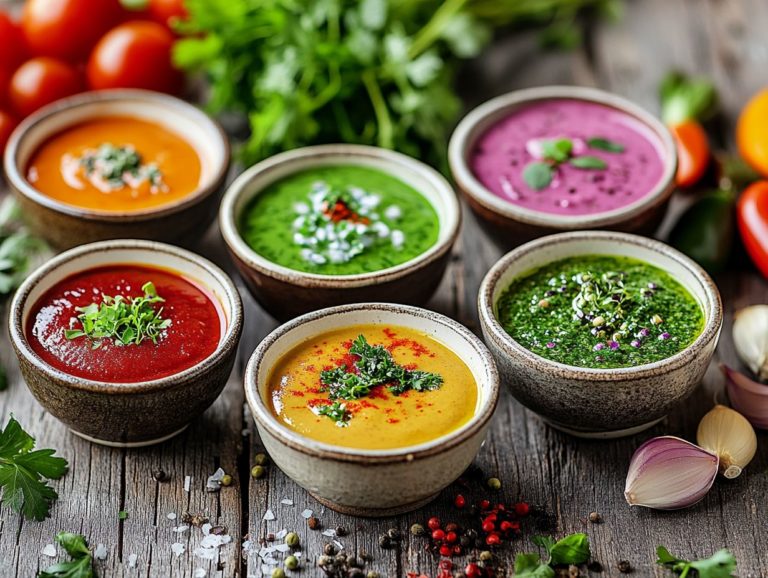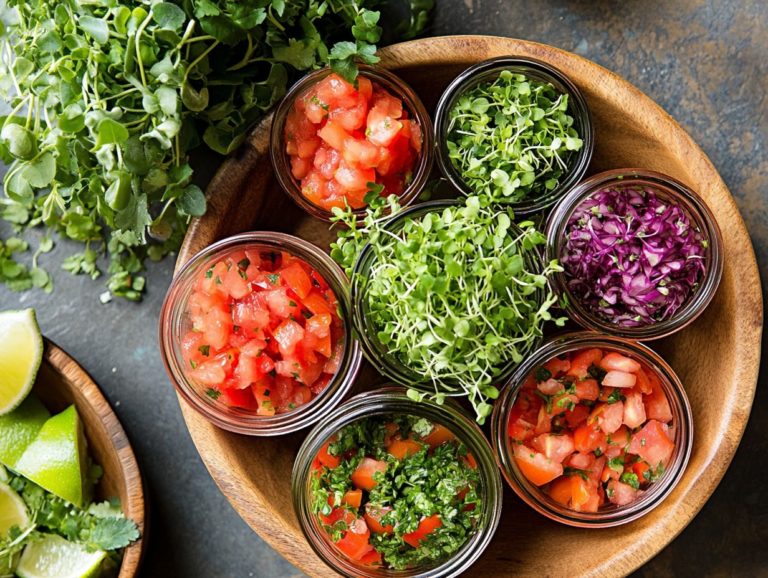4. Creative Ways to Add Microgreens to Your Meals
Microgreens are tiny, nutrient-dense powerhouses that can elevate your meals in both flavor and health benefits. Packed with vitamins, minerals, and antioxidants, these miniature greens are more than just a trendy garnish; they have the potential to transform a simple dish into a gourmet experience. Microgreens are perfect for various recipes!
This article delves into what microgreens are and their impressive nutritional value. You ll discover the various ways to incorporate them into your diet. From vibrant salads and delicious wraps to innovative smoothies, these little greens can make a significant impact in your kitchen.
Contents
Key Takeaways:
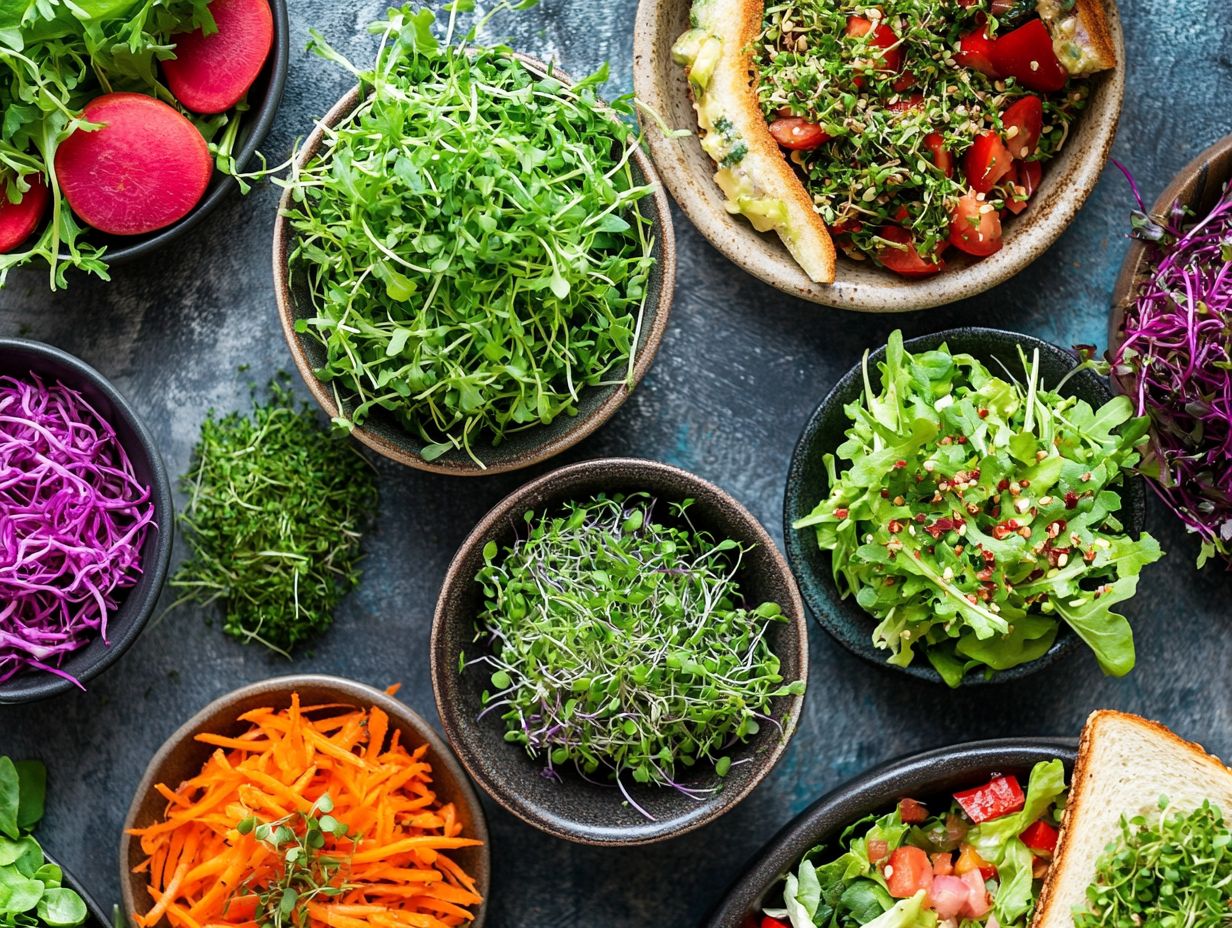
- Boost your meals with added nutrition by incorporating microgreens, which are rich in vitamins, minerals, and antioxidants.
- Get creative! Try microgreens in salads, soups, smoothies, wraps, and even baked goods for extra flavor and texture.
- Save money! Grow your own microgreens at home with simple tips, ensuring maximum freshness and a longer shelf life.
What are Microgreens?
Microgreens are young, edible plants that you can harvest just after germination, usually within 7 to 21 days. These petite greens are brimming with flavor and nutrients, making them a versatile ingredient for everything from salads to sandwiches.
They enhance your meals, offering a burst of freshness that elevates even the simplest recipes. With a wide variety of types available, you can easily incorporate microgreens into your daily diet, enjoying their health benefits while adding vibrant colors and textures to your plate.
Microgreens not only enrich your culinary creations but also highlight the endless possibilities of using fresh produce and healthy ingredients.
Definition and Nutritional Value
Microgreens are the young seedlings of edible vegetables and herbs, distinguished by their remarkable concentration of nutrients and vibrant flavors that elevate any meal.
Microgreens pack a powerful nutritional punch, brimming with an impressive array of vitamins, minerals, antioxidants, and essential nutrients. For instance, arugula microgreens are packed with vitamins A, C, and K, which support bone health and boost your immune system. Radish microgreens offer a delightful spicy kick and significant amounts of vitamin E and phytonutrients natural compounds found in plants that may improve health. Basil microgreens bring a fragrant aroma to your dishes while providing essential oils known for their anti-inflammatory benefits.
Incorporating these nutrient-dense seedlings into your diet can lead to improved health outcomes, making them a stellar choice for anyone eager to enhance their overall well-being.
Benefits of Incorporating Microgreens into Your Diet
You ll be amazed at the health benefits microgreens can bring to your meals! They elevate the nutritional value while adding vibrant flavors to your collection of recipes.
Health Benefits and Versatility
Microgreens are not just a culinary delight; they are also a powerhouse of health benefits, delivering essential vitamins, minerals, and antioxidants in a concentrated package.
Picture tiny greens like arugula and radish shoots enhancing your meals while simultaneously improving your digestion with their fiber content. They are perfect for salads and wraps. These little wonders support heart health by providing compounds that help reduce inflammation and lower cholesterol levels.
Want to watch your weight? Add microgreens to your smoothies, guacamole, or use them as a garnish on soups. This can elevate volume and nutrients without piling on extra calories. To learn more about incorporating these nutritious greens, check out how to grow microgreens for a fresh salad. By weaving these vibrant plants into your daily meals, you can craft a delicious and health-boosting routine that nurtures your overall well-being.
Types of Microgreens

Microgreens are young seedlings of edible vegetables and herbs, packed with flavor and nutrients. You ll discover an impressive array of microgreens available today, each offering unique flavor profiles and culinary applications. They are perfect for salads, sandwiches, and more. These vibrant greens can delight your kitchen, elevating your dishes with their distinct tastes and textures.
Popular Varieties and Flavor Profiles
Popular microgreen varieties include arugula, radish, and basil. Each offers distinct flavors and nutritional benefits that can truly elevate your culinary creations.
Imagine arugula, with its peppery bite, effortlessly adding a delightful zing to your salads, sandwiches, and wraps. Radish microgreens provide a crisp, slightly spicy crunch that enhances dishes like tacos and grain bowls. Meanwhile, basil microgreens deliver a delicate, aromatic flavor that pairs beautifully with tomatoes in caprese salads or as an elegant garnish for pasta dishes.
Don t overlook other notable varieties like cilantro and beet microgreens. Cilantro brings a fresh, herby essence, while beet microgreens offer a subtle earthy sweetness, making them ideal for smoothies or as vibrant toppings that add flair to various plates.
Creative Ways to Use Microgreens
Get ready to explore a world of culinary delights with microgreens! These tiny greens can transform your meals in delicious ways, whether in vibrant salads, creamy guacamole, or flavorful wraps.
In Salads and Sandwiches
Adding microgreens to your salads and sandwiches brings freshness, texture, and nutrition. Even simple meals become exciting!
These tiny greens burst with flavor and essential nutrients. For instance, a mix of arugula and cherry tomatoes when you add some sunflower or pea shoots, you ll introduce a delightful crunch along with a subtle nuttiness.
In sandwiches, consider the addition of radish microgreens; they impart a peppery zest that elevates classic combinations like turkey and cheese or hummus and avocado. This not only makes your meals more appealing but also infuses them with health benefits.
These fresh ingredients not only enhance flavors but also contribute to a balanced and nutritious meal.
As Toppings for Soups and Stews
Microgreens are perfect toppings for your soups and stews, adding flavor, delicious toppings, and a nutritious boost that elevates those warm, comforting dishes.
By adding a handful of vibrant microgreens, you enhance the presentation and elevate the taste profiles with their varied and intense flavors. For instance, peppery arugula microgreens beautifully complement a creamy potato leek soup, while sweet and crisp pea shoots offer a delightful contrast to hearty lentil stew. Adding spicy radish greens can give your butternut squash soup a refreshing kick, and nutrient-packed kale microgreens bring a robust quality to any broth-based dish. To learn more about enhancing these flavors, check out ways to enhance flavor in microgreens.
With their rich vitamin content, these tiny greens can transform even the simplest recipes into healthful masterpieces, making each spoonful both delicious and wholesome.
In Smoothies and Juices

Incorporating microgreens into your smoothies and juices is a brilliant way to boost nutrient content. This also introduces a unique flavor twist.
These tiny greens enhance the nutritional profile. They also add delightful flavors to your beverages. For instance, just a handful of radish microgreens can impart a peppery kick. Meanwhile, sunflower microgreens offer a subtle nutty essence that beautifully complements fruits.
Picture this: blending a refreshing green smoothie with spinach, banana, and a splash of almond milk! Or crafting a revitalizing juice with beets, carrots, and a touch of basil microgreens. You can even use them in your favorite breakfast drinks. These additions provide a treasure trove of vitamins, minerals, and antioxidants.
By embracing microgreens in your healthy drinks, you transform ordinary recipes into vibrant, delicious concoctions that are as pleasing to the palate as they are to your well-being.
In Baked Goods and Dishes
Microgreens can be a delightful surprise in your baked goods and various dishes. They introduce an unexpected flavor dimension while enhancing overall nutrition.
These vibrant greens unlock a realm of cooking fun. They effortlessly blend into everything from savory muffins and herb-infused breads to innovative pasta sauces and salsas. Imagine a zesty lemon loaf adorned with a medley of microgreens! Or a remarkable spinach and pea shoot ravioli that bursts with fresh taste and color. For those looking to enhance their dishes, check out these 5 creative ways to grow microgreens!
Your pizzas can reach new heights when topped with microgreens. They add an enticing crunch and a burst of flavor that beautifully complements traditional ingredients like cheese and tomato sauce. Their versatility excites the palate and enriches the nutritional profile of your meals, making every dining experience more wholesome and invigorating.
Tips for Growing and Storing Microgreens
Cultivating and storing microgreens at home offers you a truly rewarding experience, granting you access to fresh greens whenever you want while maximizing their numerous benefits.
How to Grow Microgreens at Home
Growing microgreens at home is simple and requires minimal space. This makes it a delightful and accessible venture for anyone looking to savor fresh flavors and nutrients.
With just a few basic materials and a touch of guidance, you can cultivate these tiny, nutrient-packed greens with ease. To embark on this rewarding journey, gather your materials:
- Seeds specifically designed for microgreens
- Shallow trays or pots for planting
- Quality potting soil
- A spray bottle for watering
The planting technique is refreshingly straightforward:
- Spread soil evenly in your tray.
- Sprinkle the seeds on top.
- Lightly cover them with a thin layer of soil.
From there, consistent care is key. Keep the soil moist but not soggy, ensure they receive adequate light, and monitor their growth. With just a bit of attention, you’ll be rewarded with vibrant, flavorful microgreens that can elevate countless dishes.
Proper Storage and Shelf Life
Proper storage of microgreens is crucial for maintaining their freshness and shelf life. Don’t let your fresh greens fade away! Store them properly to savor their vibrant flavors and nutrients for an extended period.
To achieve this, consider using a breathable container, such as a perforated plastic bag or a clamshell container. This allows excess moisture to escape. Storing them in the refrigerator, particularly in the vegetable drawer, is ideal. It provides a stable and cool temperature. Mastering these refrigeration techniques can significantly enhance their shelf life, typically keeping them fresh for about one to two weeks.
To assess whether your greens have seen better days, look for signs like wilting leaves, discoloration, or a slimy texture. These indicators point to a decline in freshness that could compromise both taste and nutrition.
Frequently Asked Questions
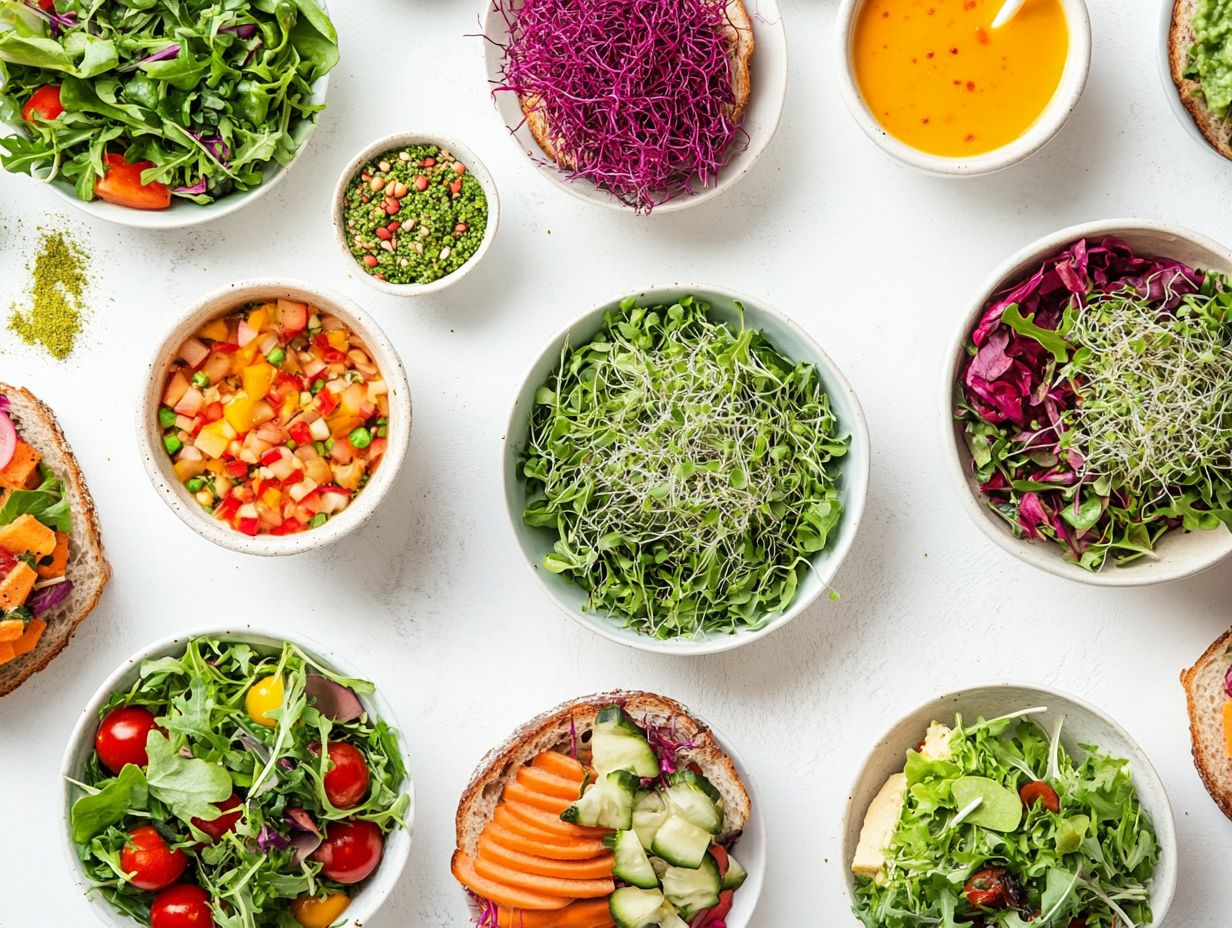
What are microgreens?
Microgreens are young vegetable greens harvested right after sprouting and before maturing. They are nutrient-rich and can spice up your meals with vibrant flavors and colors.
How can I creatively add microgreens to my meals?
Sprinkle microgreens on salads, sandwiches, or soups for an extra crunch. They also make a tasty topping for pizza or a flavorful addition to stir-fries!
Can I grow my own microgreens?
Yes, growing microgreens at home is simple! You just need a shallow tray, some soil, and seeds.
Check out online tutorials for easy, step-by-step guides to growing your own microgreens!
What types of microgreens are available?
Many varieties of microgreens exist, including arugula, broccoli, radish, sunflower, and pea shoots. Each type brings a unique flavor and nutrition, so feel free to explore and discover your favorites!
Are microgreens more nutritious than fully grown vegetables?
Absolutely! Studies show that microgreens can contain up to 40 times more nutrients than mature vegetables. They are harvested at their peak, ensuring maximum nutrient content.
Can I add microgreens to cooked dishes?
Definitely! While microgreens are great as a garnish for cold dishes, you can also incorporate them into cooked meals. Just add them at the end of cooking to maintain their nutrients and flavor!

